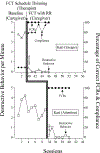Using Schedule-Correlated Stimuli During Functional Communication Training to Promote the Rapid Transfer of Treatment Effects
- PMID: 31749897
- PMCID: PMC6867805
- DOI: 10.1037/bdb0000085
Using Schedule-Correlated Stimuli During Functional Communication Training to Promote the Rapid Transfer of Treatment Effects
Abstract
Prior research has shown that bringing functional communication responses under the discriminative control of schedule-correlated stimuli facilitates rapid reinforcement schedule thinning and the transfer of functional communication training (FCT) treatment effects to other therapists and settings. In Experiment 1, we extended this body of research by rapidly transferring FCT treatment effects to a caregiver, despite the caregiver's unique and lengthy history of reinforcement of the child's destructive behavior. In Experiment 2, we evaluated the degree to which FCT treatment effects transferred to another participant's caregivers when the caregivers implemented FCT with and without schedule-correlated stimuli. Rapid transfer of FCT treatment effects occurred only when caregivers used the schedule-correlated stimuli. We discuss the use of schedule-correlated stimuli within FCT procedures as a method of programming for generalization when extending treatment to caregivers.
Keywords: destructive behavior; functional communication training; generalization; schedule-correlated stimuli.
Figures





Similar articles
-
Renewal during functional communication training.J Appl Behav Anal. 2018 Jul;51(3):603-619. doi: 10.1002/jaba.471. Epub 2018 May 21. J Appl Behav Anal. 2018. PMID: 29785807
-
Functional communication training during reinforcement schedule thinning: An analysis of 25 applications.J Appl Behav Anal. 2016 Mar;49(1):105-21. doi: 10.1002/jaba.265. Epub 2015 Oct 20. J Appl Behav Anal. 2016. PMID: 26482103 Free PMC article.
-
Evaluation of multiple schedules with naturally occurring and therapist-arranged discriminative stimuli following functional communication training.J Appl Behav Anal. 2016 Jun;49(2):228-50. doi: 10.1002/jaba.293. Epub 2016 Jan 21. J Appl Behav Anal. 2016. PMID: 26790565 Free PMC article.
-
Thinning Schedules of Reinforcement Following Functional Communication Training for Children with Intellectual and Developmental Disabilities: A Meta-analytic Review.J Autism Dev Disord. 2019 Dec;49(12):4788-4806. doi: 10.1007/s10803-019-04191-x. J Autism Dev Disord. 2019. PMID: 31456100 Review.
-
Using Chained or Tandem Schedules With Functional Communication Training: A Systematic Review.Behav Modif. 2023 Jan;47(1):185-218. doi: 10.1177/01454455221077420. Epub 2022 Feb 14. Behav Modif. 2023. PMID: 35164521
Cited by
-
Parent Ratings of Generalized and Indirect Effects of Functional Communication Training for Children with Autism Spectrum Disorder.Behav Modif. 2022 Sep;46(5):971-1001. doi: 10.1177/01454455211018815. Epub 2021 May 27. Behav Modif. 2022. PMID: 34041956 Free PMC article.
-
Teaching trainees to implement functional communication training with multiple schedules: An evaluation of training effects and durability.J Appl Behav Anal. 2024 Oct Autumn (Fall);57(4):999-1015. doi: 10.1002/jaba.2915. Epub 2024 Sep 26. J Appl Behav Anal. 2024. PMID: 39323390 Free PMC article.
-
Relative preference for distinct reinforcers maintaining destructive behavior.J Appl Behav Anal. 2024 Mar;57(2):358-371. doi: 10.1002/jaba.1051. Epub 2023 Dec 22. J Appl Behav Anal. 2024. PMID: 38131231 Free PMC article.
-
Scoping Review: Caregiver Training to Reduce Challenging Behaviors Displayed by Children on the Autism Spectrum.Behav Anal Pract. 2024 Jul 31;18(1):56-73. doi: 10.1007/s40617-024-00960-y. eCollection 2025 Mar. Behav Anal Pract. 2024. PMID: 40092342 Free PMC article. Review.
-
Relapse and its mitigation: Toward behavioral inoculation.J Appl Behav Anal. 2023 Apr;56(2):282-301. doi: 10.1002/jaba.971. Epub 2023 Jan 30. J Appl Behav Anal. 2023. PMID: 36715533 Free PMC article. Review.
References
Grants and funding
LinkOut - more resources
Full Text Sources
